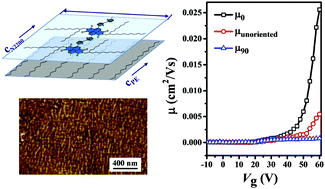Enhanced charge transport and thermoelectric performance of P(NDI2OD-T2) by epitaxial crystallization on highly oriented polyethylene substrates†
Abstract
Semiconducting polymers attract increasing attention due to both solution processability and mechanical flexibility, which enables their potential applications in flexible and stretchable electronic devices. However, their low charge mobility caused by the poor ordering of the polymer chains in condensed states hinders the development of high-performance devices. Therefore, manipulating the orientations of polymer chains in films is a long-standing direction to optimize the charge mobility and device performances. Herein, large-area anisotropic semiconducting films based on a well-known n-type polymer, P(NDI2OD-T2), are produced by epitaxial crystallization on a highly oriented polyethylene (PE) substrate. With the epitaxial face-on orientation of the P(NDI2OD-T2) chains, the electron mobility up to 0.033 cm2 V−1 s−1 is observed in the parallel direction of the polymer chains, which is 40 times higher than that in the perpendicular direction. Furthermore, the oriented P(NDI2OD-T2) films doped with N-DMBI also display anisotropic conductivity with a ratio of about 156. It thus leads to relatively high thermoelectric properties with a power factor of 2.12 × 10−3 μW m−1 K−2. This work demonstrates that epitaxy of P(NDI2OD-T2) on PE represents a powerful strategy for tuning the charge mobility toward an optimized thermoelectric performance.



 Please wait while we load your content...
Please wait while we load your content...